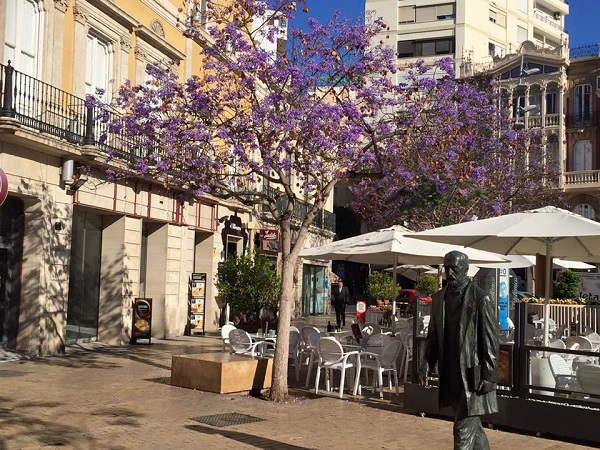
With LuxairTours now flying to Almeria in the southern Spanish coast, I was able to sample the service offering on a quick trip there this week; interestingly, the Luxair Boeing 737-800, after the early morning flight landed in Almeira, then took off for Reykjavik in Iceland in a clever piece of fleet optimisation that sees an Icelandic tour operator fly their customers from Almeira to Reykjavik, then from Reykjavik to Almeira, ready for the return flight to Luxembourg with LuxairTours passengers on board.
We took the LuxairTours Boeing 737-800 from Lux-Airport, one of the first flights out just after 06:00, and were served a fresh breakfast on board half an hour into the flight which was just over two hours in duration. Flying over southern Spain, we had a bird's eye view of the Sierra Nevada and the rugged mountains which gave way to land covered by grey-white coverings used extensively for agriculture; otherwise the landscape was fairly featureless outside the towns.
Coming in to land on the runway, we saw it was situated just a couple of hundred metres from the flat blue sea. The main difference, though, was while we left Luxembourg in torrential rain, the southern Spanish coast offered blue skies without a cloud in sight and the thermometer hitting almost 30C.
The airport was small so we were quickly through it and on our way to the region's capital, Almeria, just 20 minute away, passing tomato, cucumber and bell pepper (capsicum) cultivations along the way that we had seen from the air. The region also grows plants from which they extract fibres which are used for making ropes, etc., after being exported to Norway.
The surrounding hills/mountains in the Sierra Nevada around Tavernas may not be very high but they have been used for shooting films such as Indiana Jones and Conan the Barbarian. The region is also home to a 3.5 metre diameter telescope, one of the largest in Europe.
We took a stroll through the town with its narrow streets, spick and span, with plenty of tress offering shade and flowering shrubs providing a colourful contrast, plus a mix of old and new architecture - some still standing from before the Spanish civil war. We climbed the mount to the restored Alcazaba fortifications, allowing a wonderful view over the town, across flat-rooved buildings to the port and glistening sea beyond. The port is split into three parts, with one for large passenger ships which travel to and from Morocco, and another for the town's commercial fishing fleet.
Staying on the theme of economics for a second, we learned that the area's unemployment rate is 30%, with youth unemployment at 65%...
The town also has a statue of John Lennon, who used to visit Almeria, and the public can view around the house in which he stayed. There is also the incredibly ornate interior of the cathedral with its fortified external walls and which also offers an intriguing upper-level inner courtyard.
We had a quick spin around the surrounding towns too, all looking similar, and we headed out to Roquetas de Mar where LuxairTours has 3 hotels in their Vakanz catalogue and where we had a leisurely lunch in a restaurant on the beach.
Back to the eastern side of Almeira, this time to the Cabo del Gato nature reserve and along a 25km stretch of beach without any buildings at all on either side of the road. Once outside the towns there is very little vegetation, with the porous red sandstone support only scrub, making it clear why the region has been used for shooting westerns with notable actors such as Brigitte Bardot, Sophia Loren, Clint Eastwood, Lee van Cleef and many more.
At the end of the 25km stretch of unspoilt coastline we stopped at a lighthouse at Las Sirenas, no named as the ricky pinnacles off the headland are as beautiful as mermaids. Shortly before our stop we saw the salt lakes where the locals harvest fine salt by hand and sell it for €6 for a 125g jar. A stop at the "Salinas" confirmed there are many different birds, etc., to be seen there, including herons, egrets and flamingoes. And another stop was at a quiet secluded cove with a small jetty and s number of small fishing boats moored, with the mountain backdrops and mottled turquoise waters picture-postcard quality. Having a drink at the water's edge in the late afternoon was refreshing, relaxing and peaceful as we watched the shoals of fish swim by underneath us.
We also passed by the world-wide Michelin test centre, including a track where new tyre compounds and designs are tested prior to being marketed. This is the area where both silver and gold used to be mined.
While Almeira may not be the most developed of the Spanish tourism regions, being maybe 10-15 years behind the most developed, it is relatively unspoilt, ideal for families in the summer and retirees in the winter. The only spoiler for this is the roadside litter outside the towns and the national park; while there is never that much in any one spot, it is consistent and could be cleared up with a little effort.
How to get there: LuxairTours flies to Almeira three times weekly during the summer season (Wednesdays, Thursdays, Saturdays) and offers both packages and flight-only deals. See www.luxairtours.lu for details.
Photos by Geoff Thompson - for full photo album (on Facebook), see www.facebook.com/238112732966706/photos/?tab=album&album_id=888431557934817









